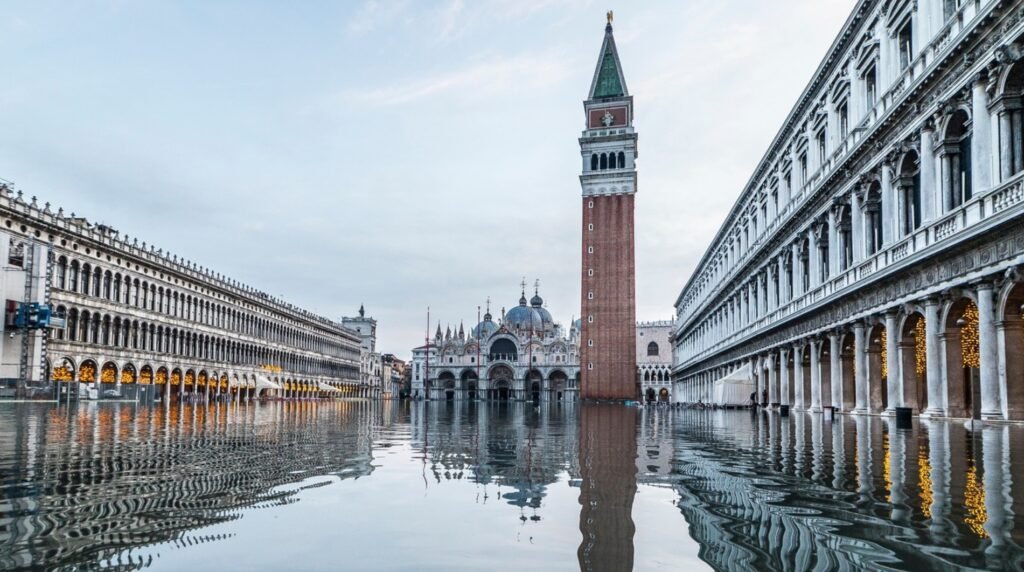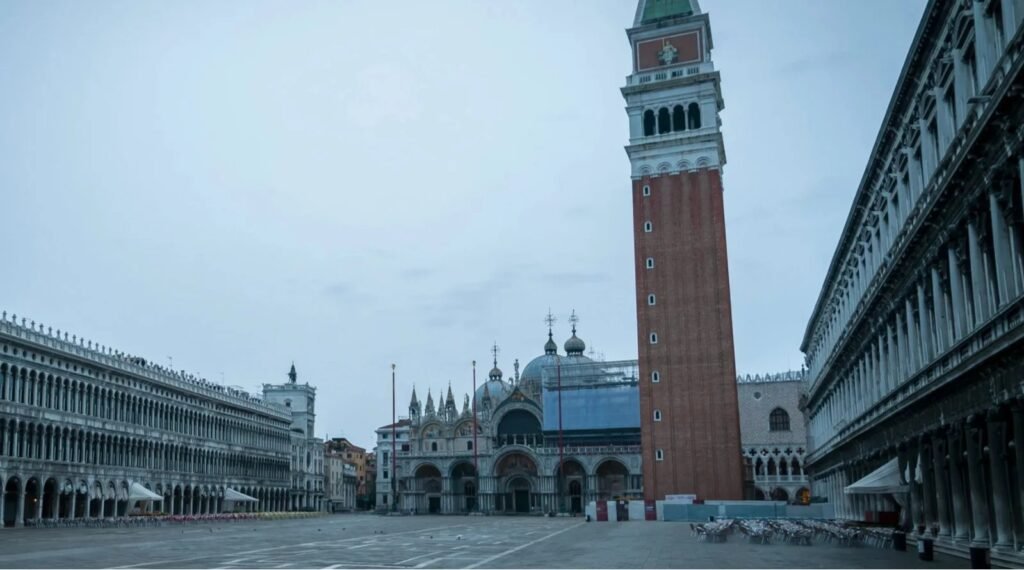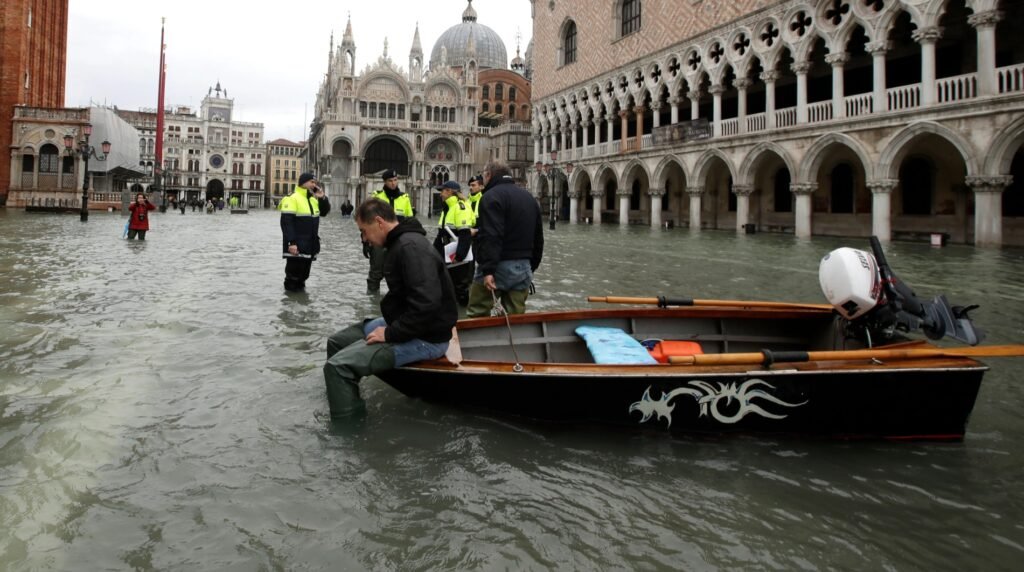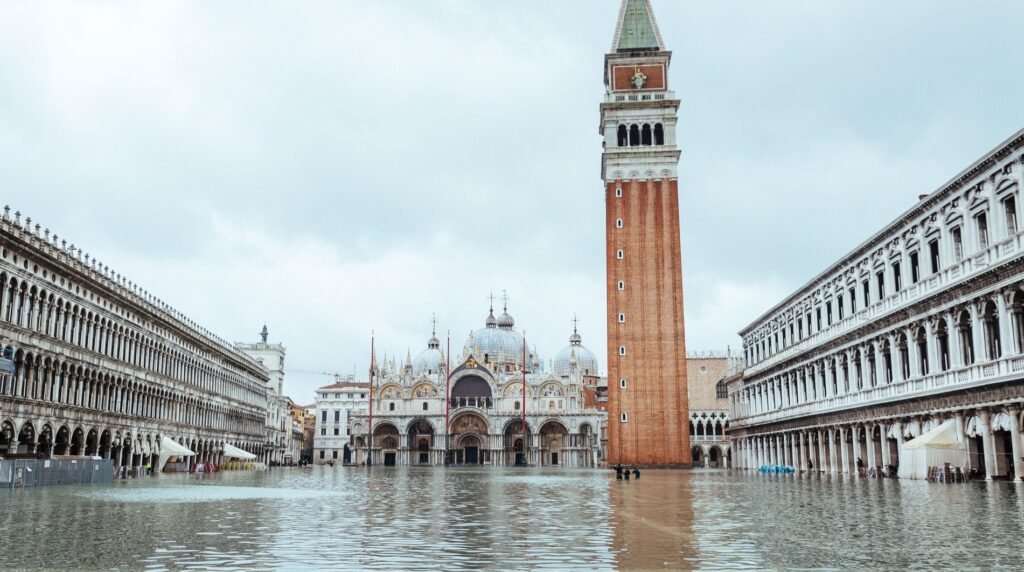The Acqua Alta Flood 2019 swept into global headlines when television cameras showed seawater roaring across the marble expanse of Piazza San Marco and lapping at the bronze horses atop the basilica façade. For Venetians, “high water” is a seasonal nuisance; yet the Acqua Alta Flood 2019 was exceptional, with a 187-centimetre tide the second-highest ever recorded turning the city’s living rooms into lagoons and reminding the world that beauty this fragile demands constant vigilance.
This article unpacks what made the event so destructive, examines the main monuments caught in the surge, and explores how officials and residents are re-thinking defences in the age of accelerating the climate.

The Setting: Piazza San Marco Before the Deluge
Long before the Acqua Alta Flood 2019 breached its paving stones, Piazza San Marco was celebrated as “Europe’s drawing room,” a stage where emperors paraded, musicians serenaded, and pigeons posed for selfies. At barely one metre above mean sea level, yet, the famous square has always been the first area to flood.
City engineers regularly install raised wooden walkways called passerelle, and café owners keep aluminum flood-bars stacked beside their doors. In November 2019, the sirens that warn of Venice inundation failed. They sounded too late for most businesses to raise their barricades. The surge arrived quickly. A sirocco wind drove the Adriatic waters directly into the lagoon.
As lights failed and gondolas broke their moorings, tourists waded waist-deep past submerged mosaics, witnessing history in real time. The episode revealed how inadequate incremental measures had become. It set the tone for the debates that would follow the Acqua Alta Flood 2019.📍Walk through and explore the place🗺️

St Mark’s Basilica: A Thousand-Year-Old Treasure in Peril
If St Mark’s Basilica were merely a church, the Acqua Alta Flood 2019 would have been a heartbreak; because it is a jewel box of Byzantine-era art, the inundation bordered on catastrophe. Built on pine piles driven into marshy soil, the basilica has endured quakes, fires, and earlier tides. Yet saltwater now reaches its marble floor more than sixty times a year.
During the November 2019 surge, brine filled the narthex within seconds, soaking eighth-century tesserae that can’t be replaced. Conservators rushed to pump out water but were forced to watch micro-cracks form in golden tiles as they dried. The basilica’s administrator later disclosed that each severe Venetian flooding event multiplies restoration costs exponentially.
Laser-scan surveys undertaken after the Acqua Alta Flood 2019 revealed accelerated decay of marble columns and bronze doors; even the celebrated Pala d’Oro altarpiece was judged at risk from airborne salt crystals left behind. The crisis propelled St Mark’s Basilica to the top of UNESCO’s emergency-fund list and reignited arguments over the delayed MOSE barrier system.
Doge’s Palace and the Political Heart of Venice
Adjacent to the basilica, the pink-and-white Gothic colonnades of the Doge’s Palace symbolize seven centuries of Venetian independence. The palace’s ground-floor prisons and colonnaded loggias, however, are just centimetres above water level. When the Acqua Alta Flood 2019 hit, archivists rushed to move parchment decrees and Renaissance paintings to upper floors. Swirling currents dislodged flagstones in the Porta della Carta courtyard, exposing timber sub-structures first laid in 1424.
Security cameras captured a chilling sight: centuries-old oak doors flexing under hydraulic pressure until iron bolts snapped. Heritage engineers later noted that repeated waterlogging threatens woodworm infestation and corrosion of wrought-iron ties hazards invisible to day-trippers but lethal to a building already leaning seaward.
Politicians convened an emergency session inside the Great Council Chamber to demand faster deployment of floodgates; opponents counter-argued that the phenomenon was a visible weather change impact demanding broader lagoon management, not just engineering fixes. The palace thus became both victim and debating hall in the aftermath of the Acqua Alta Flood 2019.

Rialto Bridge and the Commercial Lifeline
Further up the Grand Canal, the stone arch of the Rialto Bridge has linked merchants since 1591. On ordinary days its steps echo with traders hawking silk ties and vaporetto engines growling beneath. During the Acqua Alta Flood 2019, however, tidal flows surged so violently that vaporetto operators suspended service, isolating residents of the San Polo district.
Shopkeepers stacked sandbags, but water still seeped through ventilation grilles, destroying inventory in cheese stalls and leather workshops. Surveyors later measured scouring at the bridge’s foundations evidence that storm-driven currents, amplified by Venice inundation, can undermine piles thought secure for centuries.
Two instances of masonry spalling were recorded where boats struck arch stones ripped free from moorings. City planners fear that repeated shocks could induce differential settlement, altering the bridge’s iconic silhouette. Scholars at Ca’ Foscari University now use the bridge as a case study in urban resilience, noting how a single climate change impact can ripple through supply chains that begin and end at Rialto’s storied market.

Grand Canal: Transport Artery Turned Tempest
The sinuous S-curve of the Grand Canal is Venice’s highway, yet its banks are lined with palazzi whose cellars predate modern waterproofing. When the Acqua Alta Flood 2019 coincided with a full-moon tide, propulsion from wind forced a tidal bore up the canal. Vaporetto captains described waves slapping second-storey balconies; emergency crews logged 17 motor-launch collisions in three hours.
Residents of Ca’ d’Oro reported that currents lifted antique floor tiles like poker cards. Environmental scientists testing salinity levels found concentrations 40 per cent higher than previous peaks, accelerating osmosis through mortar joints. Insurance analysts placed initial damages at €1 billion for canal-facing properties alone.
Many owners blamed the delayed MOSE gates, but hydrologists argued that no barrier can neutralize every climate change impact scenario now unfolding in the Mediterranean. Instead, calls grew for dredging sediment traps and regulating cruise-ship wakes that amplify surge energy. Without such holistic measures, they warned, the Grand Canal may record another disaster rivaling the Acqua Alta Flood 2019 within a decade.
Economic Toll on Tourism and Local Businesses
Venice welcomes over 25 million visitors a year, yet the Acqua Alta Flood 2019 demonstrated how swiftly that revenue can evaporate. Hotels cancelled 45 per cent of bookings in the six weeks following the surge, while café gross receipts fell by half. Luxury watch boutiques on Calle Larga XXII Marzo lost inventory worth €13 million when safes were submerged.
Restaurateurs faced a double blow: spoiled ingredients from power outages and absent diners deterred by grim images of Piazza San Marco underwater. City economists calculated that each day of shutdown cost €3 million in GDP equivalent, a staggering figure for a municipality already struggling with depopulation. The event also highlighted systemic inequities: migrant cleaners were laid off first, whereas multinational cruise lines simply rerouted ships.
Analysts framed the crisis as a climate change impact warning to heritage cities worldwide, arguing that recovery funds must incentivize sustainable businesses, not just cosmetic repairs. Yet despite the losses, Venice’s entrepreneurial spirit endured, with artisans organizing online marketplaces and hoteliers marketing “flood-free” winter packages referencing the Acqua Alta Flood 2019 as a lesson learned.
Preservation Efforts and Future Defences
In the wake of the Acqua Alta Flood 2019, Venetian authorities accelerated completion of the MOSE barrier, a €6-billion series of inflatable gates designed to seal the lagoon during extreme tides. Engineers conducted 18 consecutive test closures, finally activating the system in October 2020 with promising results.
Yet critics warn that MOSE addresses storm surges, not groundwater rise or micro-subsidence. To protect St Mark’s Basilica and nearby monuments, the city installed glass-and-steel perimeter walls that can be raised in minutes. Conservationists are experimenting with lime-based poultices to draw salt from mosaics damaged in the disaster.
Along Piazza San Marco, drainage grates were widened to speed recession of floodwater, while architects proposed elevating the entire pavement by 17 centimetres a controversial undertaking that would alter sightlines. International donors, moved by images of Venetian flooding, pledged funds under UNESCO’s heritage-at-risk programme.
Ultimately, officials admit that no single project can eliminate danger; instead, adaptive reuse, visitor caps, and reduction of fossil-fuel traffic form part of an integrated strategy forged in the crucible of the Acqua Alta Flood 2019.
A Rising Tide of Responsibility
More than a dramatic news story, the Acqua Alta Flood 2019 stands as a turning point, forcing Venice to reconcile romance with reality. The surge exposed the vulnerability of masterpieces such as St Mark’s Basilica, civic icons like the Doge’s Palace, and commercial arteries from the Rialto Bridge to the Grand Canal. In doing so, it transformed Piazza San Marco from postcard idyll to alarm bell, ringing across seas to cities facing analogous threats.
Whether through advanced barriers, community-driven resilience, or global policy shifts aimed at mitigating climate change impact, the lessons are clear: heritage cannot be preserved by sentiment alone. As high-water sirens ring out each autumn, Venetians now gauge their response not in whispered prayers but in measured engineering and civic resolve.
The world will be watching, aware that the next chapter may once again be written in saltwater but determined that the story begun by the Acqua Alta Flood 2019 ends in safeguarding, not surrender.

The world is full of incredible oddities, and we’re committed to bringing them to your attention. If you found this article intriguing, imagine what else awaits. Our blog is a curated collection of strange and thought-provoking stories that explore the most bizarre happenings across the globe. Don’t miss out on your next fascinating discovery. Explore our blog section today.













